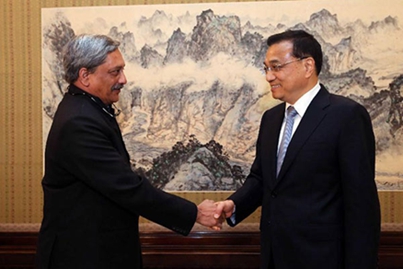By Xu Huan, associate chief editor and researcher with Foreign Theoretical Trends

On April 16, Indian Defense Minister Manohar Parrikar arrived in China for a five-day visit. On April 18, India’s External Affairs Minister Sushma Swaraj, along with his Chinese and Russian counterparts Wang Yi and Sergei Lavrov, attended the 14th China-Russia-India Foreign Ministers Meeting in Moscow.
Additionally on April 20, Indian National Security Advisor Ajit Doval arrived in Beijing for the 19th meeting of Special Representatives Talks for China-India Boundary Issues. Intensive high level interactions between Beijing and New Delhi in one week have drawn much global attention.
United States Defense Secretary Ash Carter had visited India on April 12 to sign an agreement on a US-India military logistics deal. The western media said Washington and New Delhi are enhancing defense cooperation to resist Beijing’s growing naval strength.
Amid complicated China-US-India relations, Washington expects to develop security cooperation with New Delhi and wants India to play an important role in its pivot to Asia strategy.
Nonetheless, India doesn’t want to act as a “vanguard” for the US to contain China in the Asia-Pacific region. Instead, India wants economic cooperation with China. In contrast with US-India security cooperation, China-India cooperation can be comprehensive and strategic on broader platforms.
China and India are members of BRICKS (Brazil, Russia, India, China and South Africa) and G20. They have a China-India-Russia mechanism, which make strategic coordination and negotiations go smoother.
New Delhi has joined the Shanghai Cooperation Organization (SCO), and along with the South Asian Association for Regional Cooperation, East Asia Summit and Association of Southeast Asian Nations (ASEAN), regional cooperation mechanisms such as SCO have become useful platforms for China and India to establish cooperation in middle, south and southeast Asia.
The two countries are promoting construction of the Bangladesh-China-India-Myanmar economic corridor and have strengthened cooperation under the framework of the Asian Infrastructure Investment Bank (AIIB). Yet, India hasn’t declared its willingness to join China’s Belt and Road Initiative at the moment.
Hopefully, the two countries can reach a common political consensus soon. New Delhi aspires for economic cooperation with Beijing in technology, railway construction, industrial park, clean energy, science, aerospace technology and financial fields.
Unshakable economic and people-to-people exchanges have boosted China-India relations over the past few years. In 2014 and 2015, Chinese President Xi Jinping and Indian Prime Minister Modi had made historic reciprocal state visits to develop a new type of major-country relationship between the two great powers.
China and India are the two biggest developing nations and emerging economies in the world seeking to build a multi-polarized world order.
Due to historical, cultural, geographical and economic reasons, Beijing and New Delhi have encountered some conflicts, such as territorial disputes, and will continue to meet new challenges ahead since there will always be uncertainty in the future.
Nevertheless, both sides wish to develop together, which benefits regional and global strategic coordination. To confront global challenges, it is in both countries’ interests to bury the hatchet. Hence, joint cooperation should not result in hostile confrontations, but lead to better China-India relations.
( The opinions expressed here do not necessarily reflect the opinions of Panview or CCTV.com. )

Panview offers an alternative angle on China and the rest of the world through the analyses and opinions of experts. We also welcome outside submissions, so feel free to send in your own editorials to "globalopinion@vip.cntv.cn" for consideration.















